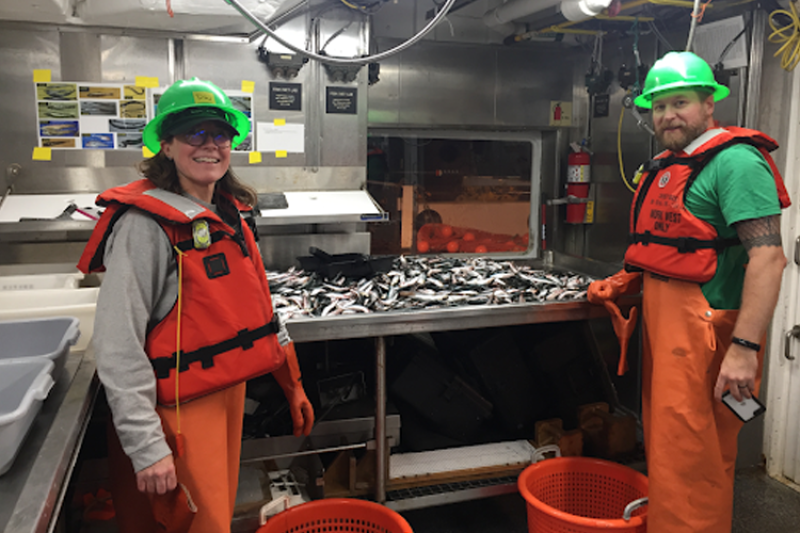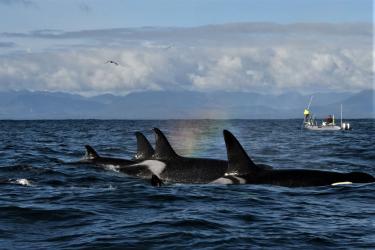Tell us a little bit about yourself. What are a few words to describe you?
I think like most people, as a child and as an adult, I’ve always been in awe of the natural world. And since high school, I have felt an urgency about conserving it. That’s how I found my way to NOAA, with a desire to improve humans’ relationship with the natural resources that sustain and benefit us. Outside of work, I’m also a wife, mother, daughter, sister, and aunt. I try to live as fully as possible in all of those roles.
What have you learned as director of the Southwest Fisheries Science Center that you are applying to your current position as the acting chief science advisor for NOAA Fisheries?
One thing I learned as director is that it’s really important to spend time listening to people who are actually conducting the work on the ground, whether that’s scientists or managers or our partners. Things can change rapidly in our line of work depending on the discipline or area of research. So keeping our ear to the ground is key. Also, it’s important to use the position to help make connections that otherwise wouldn’t be made that propel both people and the agency’s goals forward.
What might someone be surprised to learn about you?
I once worked for the city of San Diego’s municipal waste department! I worked on a binational committee with Tijuana, Mexico, focused on recycling and diverting waste from landfills. I also taught young kids English in a rural part of Spain. I’ve not done much teaching, but I really enjoyed that experience. And teaching in a foreign country was an added challenge because my Spanish had to be pretty darn good!
Where did you grow up? Did you always have a love of science?
I was born in Wisconsin but grew up in Solana Beach, California. With the beach in my backyard, I always had a strong love for the ocean and a curiosity about how its resources can be sustained. I was a bit of a late bloomer in terms of science and science management as a focus in my career. I came to it later than some.
What is your educational background?
I studied sociology and public policy. People are sometimes surprised I have a social science background. But I always say that the problems that NOAA is confronting are complex and require people from many different kinds of backgrounds to solve them. And like others, I’ve learned a lot from other cultures and life outside of my formal education, as well.
How long have you worked for NOAA, and where did you get your start?
I’ve been with NOAA for 23 years. I started my career at the Office of Oceanic and Atmospheric and Research in their headquarters offices, which worked closely with their field laboratories, cooperative institutes, and a wide range of research programs. There my focus spanned both the “dry” side and “wet” side of NOAA, as we sometimes say.
What do you like to do outside of work?
I try to make time for vacation each year. I often pick somewhere in the mountains with my family. My daughter was just telling me that she has collected 21 National Park ranger badges. That should give you an idea of how much time we’ve spent visiting them over the last decade! I like to travel, camp, and spend time outdoors. I am also very close with my extended family. I have 21 first cousins on just one side of the family! And on the other side we boast a working maple syrup farm that’s fun to visit.
Is there a book, quote, mentor, or other individual that influenced you to be the person that you are today? Tell us why.
Ah, so many. I’ve been very fortunate to have more than a handful of mentors within NOAA who have taken the time to talk with me, help shape my leadership needs and skills, and make sure I was taking the next steps in my career. I’m very thankful for that. My paternal grandparents were a huge influence, too. As Wisconsin dairy farmers of German descent, they taught me a tremendous amount about hard work and natural resource management. They farmed from the 1930s to the 1970s. There is a lot of grit that comes from that lifestyle!
What are some of your main goals for supporting and expanding our science?
One of our overarching goals is to support our people first and foremost in the hybrid work environment that we’re all in. We are working on continuing actions that make NOAA Fisheries an employer of choice. And as a science agency, another big one is how we collect, manage, and acquire data—our efforts are to ensure adequate capacity to manage data and access to the right platforms to collect it. A third goal is making sure that the NOAA Fisheries Science Board, made up of science leaders around the country, is functioning as a true directional body for the agency. All of these efforts will provide NOAA Fisheries a good position for the future.
Climate change has been shifting conditions across the globe. How is NOAA Fisheries continuing to work to combat climate change?
Quite a lot is going on regarding our changing climate. While we can’t directly combat it, we can and are working to make our nation’s fisheries more resilient in the face of climate change. The NOAA Fisheries national Climate Science Strategy and Regional Action Plans are a good start. These plans help us find ways to track ecosystem status and changes to provide early warning of events as much as we can. For instance, helping better warn about events such as marine heatwaves in the North Pacific that might affect West Coast and Alaskan fishermen, or red tide events in the Southeast that can cause significant disruptions and health impacts. This spring, we also launched a new tool to better track the location and movement of marine fish in U.S. waters. The Distribution Mapping and Analysis Portal reveals that the ranges of many marine species are shifting, expanding, and contracting in response to changing ocean conditions.
We’re also working to provide climate vulnerability analyses for different fish and marine mammal species that tell what species are most vulnerable to environmental changes in temperature, acidification, or oxygen. All of this information will help fishery management councils and other management partners deal with the climate change effects they are already seeing. Fish stocks are changing distributions between international borders and even fishery management council boundaries. Fishing communities are seeing losses and gains as the stocks change distribution. We are working diligently to get these kinds of tools directly into fishery managers’ hands.
Looking ahead, what are some of our agency’s biggest science priorities?
We are examining what data we need to collect to conduct our mission. Coming soon is our Data Acquisition Plan, which we will use to guide future data investments and decisions. Related to climate, one of the programs for which we are requesting support from Congress is the Climate, Ecosystems, and Fisheries Initiative. This will begin to build an end-to-end ocean modeling and decision support system, helping inform us about species distribution changes we are seeing in our ecosystems and paths forward to manage our trust resources. In essence, we are looking to add more predictive capability to our science—helping fishery managers know what they can expect this year, or in 10 years. Another area of emphasis is continuing to provide the science to stabilize species on the Endangered Species list that we are responsible for as trust species.
Any areas of research or advanced technologies you’re particularly intrigued by?
- Autonomous systems are the future of observing systems. We are testing and acquiring new ones each year, and it’s exciting to see the evolution in what these systems are able to do for us.
- Genomics tools, such as high quality reference genomes, are revolutionizing the way we differentiate and assess populations for conservation.
- Artificial intelligence is helping us in a variety of applications to study things like animal behavior more closely, allowing more fine scale management of fish like salmon, who live part of their lives in freshwater.
There are also other, less prominent but important techniques we are using—stable isotope analysis, for example—which is opening up worlds of knowledge regarding habitat use by species and their food habits. To me personally, one of the more intriguing areas of research is done at the interface of social and ecological systems to understand better how humans use (or don’t use) information about their changing environment to make decisions. This type of research will be increasingly important.
What gives you hope?
We have a lot of emerging threats to the species we manage at NOAA Fisheries. But I am continually blown away by the level at which our dedicated staff work to apply their knowledge to come up with solutions. Sometimes it can feel like we make very incremental progress on these challenges, but over time, you see the small changes really do add up.
Do you have a favorite NOAA Fisheries memory?
I got to help open a brand new NOAA laboratory in La Jolla, California, which is an experience I treasure. Constructed in 1964, the original lab was very near and dear to many. But it’s not a stretch to say that the new lab is one of the finest facilities in the federal government. Within a couple of years of opening the lab, I got to sail on one of the first shakedown cruises on the NOAA ship Reuben Lasker. Both of those are jewels in NOAA’s crown if you ask me. I’ve been lucky to be a part of an organization that benefits from both. And it’s two-fold: I’m proud to have the memories, yes, but equally proud of the science the lab and ship help conduct.







